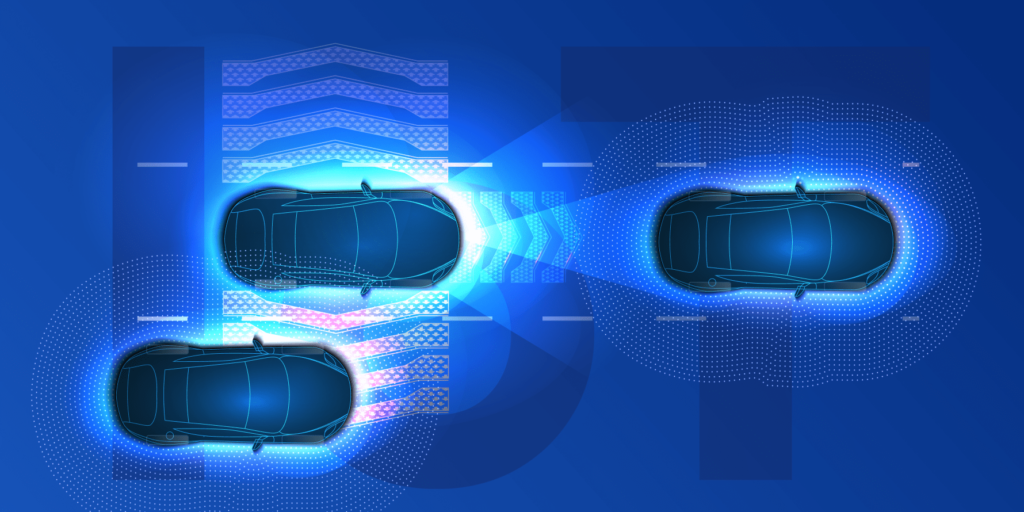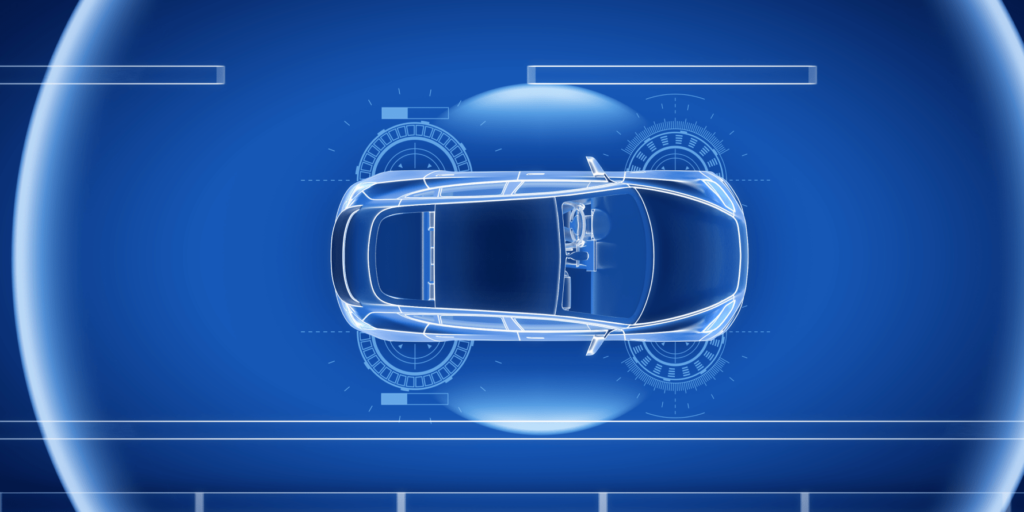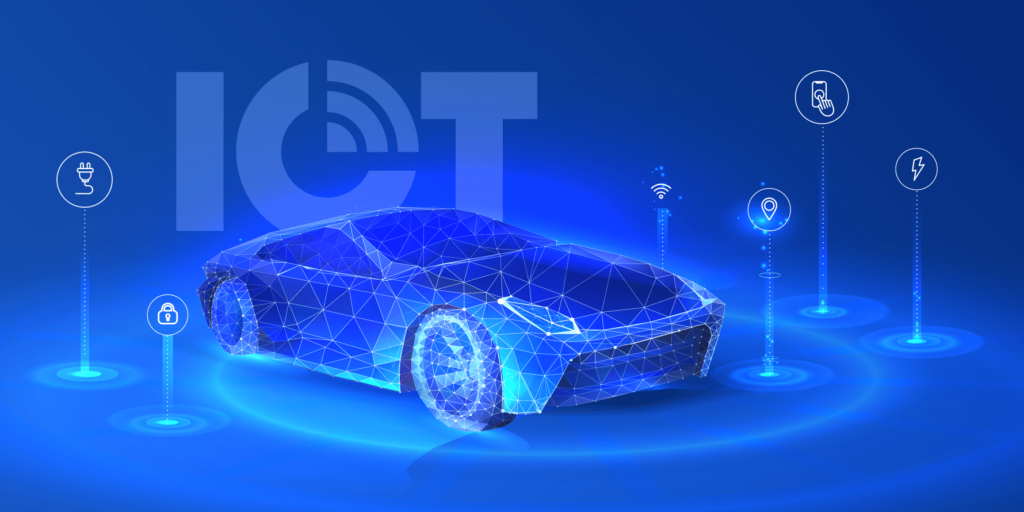Table of Contents
The Internet of Things technology has transformed multiple industries, and automotive is no exception. With apps spanning industrial and commercial domains, automotive IoT has become a dynamic hub for diverse multifunctional uses. Smart machines we once only saw in sci-fi films are now real. They offer many advantages, including safer driving and greater efficiency in terms of maintenance and route planning.
In this article, we embark on a journey into the world of IoT in the Automotive industry, exploring its far-reaching implications, the innovations and challenges it brings, and the promising future it paints for vehicles and the ways we use them.

IoT in the automotive industry
Internet of Things refers to a network of connected devices that communicate and share collected data. For the automotive industry, this technology has unlocked numerous opportunities for introducing new services, such as enhanced navigation systems and better safety. Various automotive IoT use cases have emerged, reshaping the ways how drivers and manufacturers manage vehicles. Let’s explore each of these cases individually.
IoT use cases in automotive industry
While there are numerous use cases for the Internet of Things in the automotive industry, we will focus on the ones that are already being implemented and that bring real value to both drivers and passengers, as well as manufacturers and fleet owners.
Connected cars
Connected cars are equipped with a range of sensors that communicate with each other and that allow information collection and exchange. In this way, these cars collect and analyze the data in real-time, informing drivers on the safest decisions and allowing them to effectively plan their routes.
There are five possible communication levels for connected cars:
- Vehicle to infrastructure (V2I): Cars exchange data with infrastructure like traffic lights and signs, providing real-time updates, optimizing routes, and enhancing safety.
- Vehicle to Vehicle (V2V): Vehicles communicate directly, sharing safety-related information to prevent accidents by anticipating nearby vehicle actions.
- Vehicle to pedestrians (V2P): Extending connectivity to pedestrians and road users, enabling alerts and warnings via smartphones or wearables, enhancing safety.
- Vehicle to cloud (V2C): Vehicles exchange data with cloud-based platforms for real-time traffic, weather updates, remote diagnostics, and software updates.
- Vehicle to everything (V2X): Encompassing all forms of vehicle communication, V2X creates an interconnected ecosystem for safer and more efficient transportation.
The main advantage that connected cars bring is effective route optimization and enhanced security on the road. Through the analysis of information from diverse sources like GPS, traffic sensors, and weather forecasts, these connected vehicles can recommend the most efficient routes while steering clear of congested zones and potential risks. This not only saves time but also reduces fuel consumption and emissions.
Moreover, connected cars can improve safety by providing advanced driver assistance systems. These systems use sensors and cameras to monitor the vehicle’s surroundings and to provide warnings or take preventive actions in case of potential collisions or unsafe driving conditions. For example, a connected car can detect a pedestrian crossing the road and automatically apply the brakes to avoid an accident.
Autonomous Vehicles
While connected cars enhance safety and convenience, autonomous vehicles take it a step further by eliminating the need for human drivers altogether. These self-driving cars rely heavily on IoT technology to self-navigate and make decisions on the road.
Various manufacturers strive to create 100% self-driving cars capable of taking over all driving functions. Although significant progress has been made in this field, the development of a completely independent vehicle is still ongoing.

Thus, semi-autonomous vehicles have been introduced as a temporary solution. These cars utilize sensors, cameras, and AI algorithms to detect their surroundings and make instant decisions. They can aid drivers with various tasks, such as parking or changing lanes.
By analyzing data from various sources, such as radars, LiDAR, and GPS, autonomous vehicles can navigate through complex traffic situations and respond to unexpected events.
The impact of autonomous vehicles extends widely. They hold the potential to decrease road accidents and fatalities, considering that human errors are a major contributor to such incidents. Additionally, autonomous vehicles can enhance traffic flow by establishing communication among themselves and with the surrounding infrastructure, leading to route optimization and congestion avoidance.
Fleet management
Fleet management is a critical aspect of the automotive industry. IoT technology brought real-time data collection and insights analysis to the fleet management process. Modern trucks are equipped with a range of sensors, including those for weight measurement and location tracking. Data gathered from these sensors within a sizable fleet is stored in a cloud-based application. This information undergoes processing through a range of analytical tools, rendering it in a visual format.
Using these insights, fleet managers can:
- Automatically compute optimal routes.
- Keep a real-time overview of the fleet’s whereabouts.
- Monitor cargo weight and volume.
- Retrieve performance statistics such as fuel consumption and mileage for trucks.
- Observe drivers’ behavior.
- Monitor the traffic state on the road.
- Evaluate vehicle performance.
As a result, fleet management has evolved into a more efficient process, reducing manual work and saving valuable time compared to traditional methods.
Car sharing
IoT in automotive industry has also played a crucial role in the success of car sharing services. As we already mentioned, IoT devices, such as GPS trackers and telematics systems, are used to gather real-time data about the vehicle’s location, condition, and performance. This data is then transmitted to a centralized platform, where it can be accessed by both the car sharing service provider and the users. This connectivity allows for efficient fleet management, ensuring that vehicles are available when and where they are needed.
One of the key challenges in car sharing is to ensure that the vehicles are in good condition and ready for use. With IoT, car sharing providers can remotely monitor the health of their fleet. For example, sensors can detect low tire pressure or engine issues and alert the service provider, allowing them to address the problem promptly.
Moreover, IoT simplifies access and authentication for car sharing users. Through a mobile app or a smart card, users can easily locate and unlock available vehicles. The IoT in car communicates with the app or the card, verifying the user’s identity and granting access to the vehicle. This eliminates the need for physical keys and streamlines the entire booking and pick-up process.
Furthermore, IoT enables real-time feedback and support for car sharing users. Sensors in the vehicles can detect aggressive driving behavior, speeding, or other violations, and provide instant feedback to the user. This feedback encourages responsible driving and promotes road safety. Additionally, IoT devices can offer assistance in case of emergencies, such as automatically contacting emergency services in the event of an accident or breakdown.
Connected Infotainment Systems
IoT has transformed infotainment systems in cars, offering a seamless and personalized entertainment experience for drivers and passengers. Connected infotainment systems provide access to a wide range of digital content, including music, movies, and online radio. Besides, they offer integration with smartphones, allowing users to make hands-free calls, send messages, and access navigation services. Moreover, these solutions can also provide instant updates on weather conditions, traffic congestion, and nearby points of interest. By integrating the IoT technology into infotainment systems, automakers are enhancing the driving experience and making journeys more enjoyable and productive.Predictive maintenance
Predictive maintenance stands as a significant IoT use case in the automotive sector. Traditional maintenance schedules rely on fixed time or mileage intervals, often proving inefficient and costly. Internet of Things technology revolutionizes sustenance by continuously monitoring vehicle conditions and forecasting maintenance needs based on actual usage and wear.
Through the collection of data from various sensors, including temperature, vibration, and oil pressure, IoT systems analyze patterns and pinpoint anomalies that may signal impending failures. This data-driven approach empowers automotive companies to schedule maintenance and repairs as needed, eliminating unnecessary downtime and reducing expenses.
Moreover, predictive maintenance can enhance vehicle safety by identifying potential issues before they become critical. For example, if an IoT system detects abnormal tire pressure, it can alert the driver and recommend immediate action, thus preventing accidents caused by tire blowouts.
Benefits of Automotive IoT

Indeed, one of the primary advantages of IoT in the automotive industry is the ability to link vehicles to the Internet, fostering simultaneous communication between vehicles, infrastructure, and drivers. But there are even more advantages of IoT in automotive industry:
- Real-time monitoring and alerts. Automotive Internet of Things allows for the continuous monitoring of vehicle parameters, such as engine health, fuel levels, and tire pressure, in real-time. This enables early detection of issues, reduces the risk of breakdowns, and improves overall safety.
- Enhanced efficiency. IoT devices in vehicles can provide valuable insights on driver behavior and vehicle performance. This data can be used to optimize routes, reduce idle time, and improve driver behavior, leading to increased efficiency and productivity.
- Optimized route planning. IoT-enabled vehicles can access real-time traffic data and weather information. This helps drivers and fleet managers make informed decisions about route planning, and avoid traffic congestion and adverse weather conditions, ultimately saving time and resources.
- Remote vehicle control and management. With Automotive IoT, vehicles can be distantly controlled and managed. This includes features like remote engine start/stop, lock/unlock doors, and even geofencing. In this way, users have more control over their vehicles, enhancing security and operational flexibility.
- Fuel efficiency optimization. IoT devices can provide insights into fuel consumption patterns and driver behavior. By analyzing this data, organizations can implement fuel-saving strategies, such as reducing excessive idling and maintaining optimal speeds, leading to significant fuel cost savings.
- Predictive Analytics. As we already mentioned, IoT sensors and data analytics enable predictive maintenance. By continuously monitoring the car’s condition, IoT can predict when components are likely to fail, allowing for scheduled maintenance. This minimizes downtime and reduces maintenance costs.
Challenges and concerns in automotive IoT implementation
As vehicle connectivity grows, the potential for unauthorized access to sensitive data, including personal information and driving patterns, becomes a significant concern. However, this isn’t the sole issue at hand.
Cybersecurity
IoT devices collect overwhelming amounts of data and this raises concerns about potential security breaches and unauthorized access to sensitive information.
Connected cars can be highly vulnerable to cyber-attacks, which, in turn, might have severe consequences. For example, hackers can potentially access the vehicle’s system, such as its brakes or steering, thus causing accidents.
In addition personal information collected by IoT sensors (i.e., vehicle location) can be exploited if not adequately protected. Therefore, strict security measures must be in place to safeguard both the car and the data it generates.
Interoperability
Another challenge is interoperability. Interoperability issues can arise when different manufacturers use different communication protocols or when updates or upgrades are required. Establishing standards and fostering collaboration among industry stakeholders are vital steps to ensure a seamless user experience and trouble-free interoperability.
Integration with existing infrastructure
For connected cars to fully realize their potential, they need to be able to interact with existing infrastructure, such as traffic lights and road signs. This requires a robust and reliable communication network that can handle the exchange of real-time data.
Additionally, the infrastructure itself needs to be upgraded and adapted to accommodate connected vehicles, which can be a costly and time-consuming process.
Ethical and social considerations
The IoT raises ethical and social considerations. For example, with the proliferation of IoT devices, there is the potential for increased surveillance and invasion of privacy.

Furthermore, there are concerns about the impact of the IoT on employment, as automation and AI technologies replace certain job roles. Ethical considerations also come into play when implementing IoT in automotive manufacturing. For example, self-driven cars are programmed to make split-second decisions in potentially dangerous situations. These decisions may involve weighing the risk to the vehicle occupants against the risk to pedestrians or other road users. The ethical implications of such decision-making algorithms need to be carefully considered and transparently communicated to the public.
Liability in case of accidents
As our means of transport become more interconnected and self-driven, the lines between human and machine responsibility become blurred. In the event of an accident, determining who is at fault becomes a complex task.
For instance, if a self-driving car gets involved in a collision, should the blame fall on the car manufacturer, the software developer, or the vehicle owner? This raises questions about legal frameworks and insurance policies that need to be updated to accommodate the changing landscape of liability in the automotive industry.
To address this challenge, stakeholders in the automotive industry need to work together to establish clear guidelines and regulations that define liability in the context of IoT-enabled vehicles. This includes defining the responsibilities of different parties involved in the development, manufacturing, and operation of these vehicles. Additionally, insurance companies need to adapt their policies to cover the risks associated with IoT-enabled automobiles.
Data ownership and usage
Connected cars generate vast amounts of data, ranging from vehicle diagnostics and performance metrics to driver behavior and personal information. This data can be highly valuable to various stakeholders, including car manufacturers, service providers, and advertisers.
However, the question arises: who owns this data and how should it be used? Should car manufacturers have unrestricted access to the data collected by their vehicles, or should the owners have control over their own data? Furthermore, how can this data be safeguarded from unauthorized access and potential misuse?
To address these concerns, a comprehensive framework for data ownership and usage needs to be established. This framework should provide clear guidelines on data ownership rights, consent requirements, and data protection measures. Additionally, industry-wide standards and protocols should be developed to ensure data security and privacy.
Conclusion
Despite all the challenges, the IoT presents immense opportunities for innovation and advancement. It has the potential to transform industries, improve efficiency, and enhance our quality of life. Besides, the journey of IoT in the automotive industry is far from over. As technology continues to evolve, there are limitless possibilities to further improve safety, efficiency, and the overall user experience.
However, it is crucial that we approach the development and deployment of IoT technologies with caution, ensuring that appropriate safeguards are in place to protect privacy and security and that the benefits are distributed equitably.


Comments